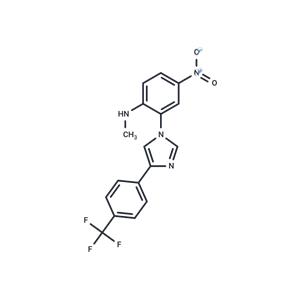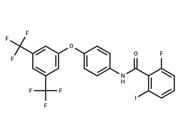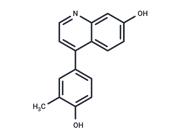| Name | CU-T12-9 |
| Description | CU-T12-9 is a potent TLR1/2 agonist(EC50 of 52.9 nM in HEK-Blue hTLR2 SEAP assay). It acts by activating the NFkB pathway, upregulating proinflammatory cytokines, and enhancing TLR1 and TLR2 dimerization.CU-T12-9 activates both the innate and the adaptive immune systems. CU-T12-9 selectively activates the TLR1/2 heterodimer, not TLR2/6. CU-T12-9 signals through NF-κB and invokes an elevation of the downstream effectors TNF-α, IL-10, and iNOS. |
| In vitro | CU-T12-9 directly targets TLR1/2 to initiate downstream signaling. It specifically induces TLR1/2 activation, which can be blocked by either the anti-hTLR1 or anti-hTLR2 antibody, but not the anti-hTLR6 antibody. By binding to both TLR1 and TLR2, CU-T12-9 facilitates TLR1/2 heterodimer formation, activating downstream signaling. Fluorescence anisotropy assays revealed competitive binding to the TLR1/2 complex between CU-T12-9 and Pam3CSK4, with an IC50 of 54.4 nM. CU-T12-9 signals through nuclear factor κB (NF-κB) and elevates downstream effectors tumor necrosis factor-α (TNF-α), interleukin-10 (IL-10), and inducible nitric oxide synthase (iNOS)[1]. |
| Storage | Powder: -20°C for 3 years | In solvent: -80°C for 1 year | Shipping with blue ice. |
| Solubility Information | DMSO : 250 mg/mL (690.02 mM), Sonication is recommended.
|
| Keywords | obesity | inflammatory | carcinoma | cancer | Toll-like Receptor (TLR) | TLR1/2 | diseases | specific | infectious | bladder | CU-T-12-9 | CUT129 | CU-T12-9 | Inhibitor | breast | asthma | CU T12 9 | inhibit | influenza | pancreatic |
| Inhibitors Related | Polyinosinic-polycytidylic acid sodium | CU-CPD107 | Imiquimod hydrochloride | Hydroxychloroquine | Chloroquine phosphate | Hydroxychloroquine sulfate | Chloranil | Chloroquine | CU-115 | Imiquimod | TLR3-IN-1 | Resiquimod |
| Related Compound Libraries | 细胞重编程化合物库 | 经典已知活性库 | 膜蛋白靶向化合物库 | 细胞焦亡化合物库 | NO PAINS 化合物库 | 肿瘤免疫治疗小分子化合物库 | 已知活性化合物库 |

 United States
United States



